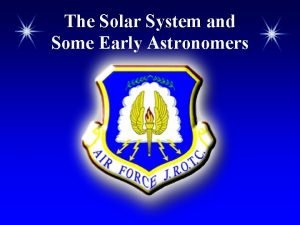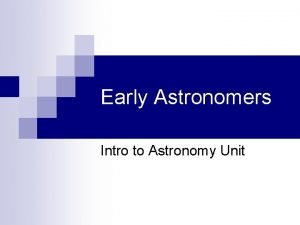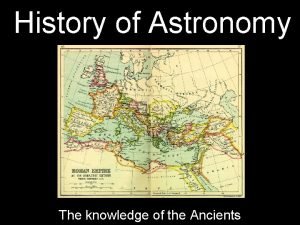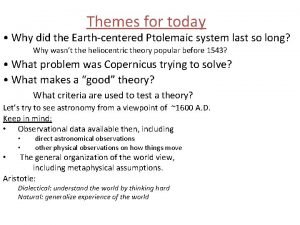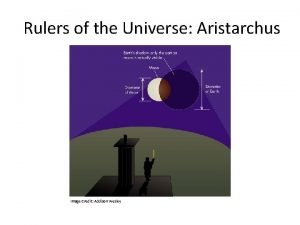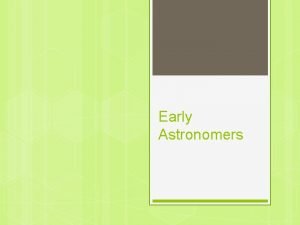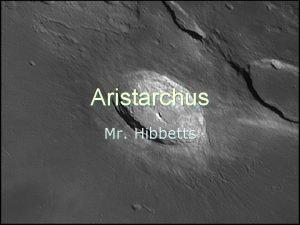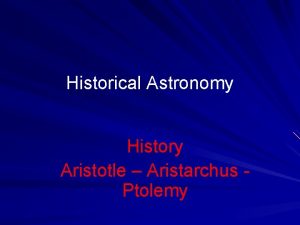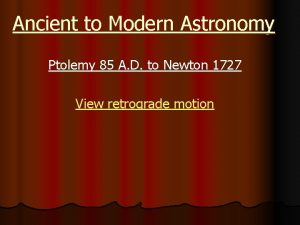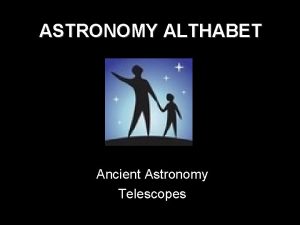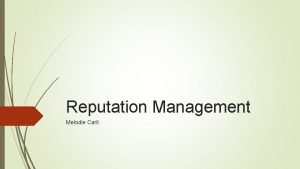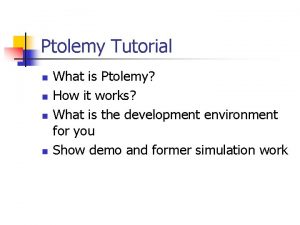Lecture 3 Ancient astronomy Aristarchus Ptolemy Modern astronomy









- Slides: 9

Lecture 3 Ancient astronomy Aristarchus, Ptolemy Modern astronomy Copernicus, Tycho, Galileo, Kepler, Newton Circular satellite motion and tide Light Speed of light, Nature of light, EM radiation, Relation to temperature, Black body radiation, Wien’s law, SB law, Planck’s law, Kirchoff’s law, Bohr model, Doppler effect

By reading this chapter, you will learn 4 -1 How ancient astronomers 4 -6 The ideas behind Newton’s laws, attempted to explain the which govern the motion of all motions of the planets physical objects, including the 4 -2 What led Copernicus to a planets Sun-centered model of 4 -7 Why planets stay in their orbits and planetary motion don’t fall into the Sun 4 -3 How Tycho’s naked-eye 4 -8 What causes ocean tides on Earth observations of the sky revolutionized ideas about the heavens 4 -4 How Kepler deduced the shapes of the orbits of the planets 4 -5 How Galileo’s pioneering observations with a telescope supported a Suncentered model

Ancient astronomy • Aristotle( 384 -322 BCE) concluded from observations of the curved shadow of the Earth on the Moon during a lunar eclipse that the Earth was spherical. • In addition, he noticed that stars were visible in some southern locations, while not visible in northern locations. Again, the Earth must be spherical for this to happen! • Solar eclipse: distance between Earth&Moon must be smaller than Earth&Sun: Not all celestial objects are at equi-distance. • Phases of the moon: the moon must be a sphere! • Around 200 B. C. , the Greek astronomer Eratosthenes made the first reasonable measurement of size of the Earth

• Aristarchus used the triangulation, he calculated the distances to the Sun and Moon


Geocentric model Epicycle Planet Earth Deferent


Change the fixed object to investigate the apparent motion of the planets. Fix the blue object to see how superior planets appear to move. Fix the red object to see how inferior planets appear to move.

Any questions on ancient astronomy? 1. 2. 3. 4. Who was the first person to measure the size ( circumference) of the Earth? A) Pythagoras, b) Aristotle, c) Aristarchus, d) Eratosthenes, e) Ptolemy The concept of the Universe adopted by most ancient Greek philosophers was (a)Earth-centered, with Sun, Moon, planets and the stars orbiting around a stationary Earth. (b)Suncentered, with Earth, Moon, planets and the stars orbiting around a stationary Sun. (c)stationary, the fixed Sun, Moon, planets and the stars appearing to move when viewed from a rotating Earth. Epicycles are used in a geocentric model to explain the a) eastward motion of Mars. b) westward motion of Mars. c) phases of Venus. d) appearance of Venus in the early morning or late evening sky. What model did ancient astronomers use to explain the motions of the planets?
 Claudius ptolemy astronomy contributions
Claudius ptolemy astronomy contributions Claudius ptolemy astronomy contributions
Claudius ptolemy astronomy contributions Learning astronomy by doing astronomy
Learning astronomy by doing astronomy Learning astronomy by doing astronomy
Learning astronomy by doing astronomy Learning astronomy by doing astronomy activity 1 answers
Learning astronomy by doing astronomy activity 1 answers Astronomy in ancient rome
Astronomy in ancient rome Aristarchus
Aristarchus Aristarchus model
Aristarchus model Aristarchus
Aristarchus Eratosthenes and aristarchus
Eratosthenes and aristarchus
